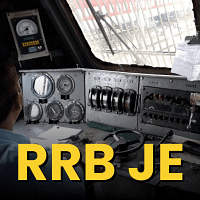Railways Exam > Railways Questions > Which of these is/are example(s) of Newton's...
Start Learning for Free
Which of these is/are example(s) of Newton's 3rd Law of Motion?
- a)Recoil of a gun
- b)Motion of a rocket
- c)Swimming
- d)All of the above
Correct answer is option 'D'. Can you explain this answer?
| FREE This question is part of | Download PDF Attempt this Test |
Verified Answer
Which of these is/are example(s) of Newton's 3rd Law of Motion?a)Reco...
A force is a push or a pull that acts upon an object as a result of its interaction with another object.
View all questions of this test
According to Newton, whenever objects A and B interact with each other, they exert forces upon each other. These forces are called action and reaction forces and are the subject of Newton's third law of motion. Formally stated, Newton's third law is:
For every action, there is an equal and opposite reaction.
All the above given options are examples of the stated law.
Most Upvoted Answer
Which of these is/are example(s) of Newton's 3rd Law of Motion?a)Reco...
Newton's 3rd Law of Motion states that for every action, there is an equal and opposite reaction. This means that whenever an object exerts a force on another object, the second object exerts a force of equal magnitude in the opposite direction on the first object. Let's examine the given options to determine which ones demonstrate this law:
a) Recoil of a gun:
- When a gun is fired, the bullet is propelled forward with a certain force.
- According to Newton's 3rd Law, the gun experiences an equal and opposite force, causing it to recoil backward.
- This demonstrates the action-reaction pair of forces acting between the gun and the bullet.
b) Motion of a rocket:
- Rockets work on the principle of action and reaction.
- The rocket engines expel gases with a high velocity in one direction (action).
- As a result, the rocket experiences a force in the opposite direction (reaction) that propels it forward.
- This exemplifies Newton's 3rd Law as the action of expelling gases leads to the reaction of the rocket's motion.
c) Swimming:
- Swimming involves the movement of a person through water by exerting force against it.
- When a swimmer pushes against the water with their arms and legs, the water exerts an equal and opposite force on the swimmer.
- This force helps propel the swimmer forward, demonstrating Newton's 3rd Law.
d) All of the above:
- As explained above, both the recoil of a gun, the motion of a rocket, and swimming involve the application of Newton's 3rd Law of Motion.
- In all these cases, an action force is exerted, and an equal and opposite reaction force is experienced.
In conclusion, all of the given options (a, b, and c) are examples of Newton's 3rd Law of Motion, as they demonstrate the concept of action and reaction forces.
a) Recoil of a gun:
- When a gun is fired, the bullet is propelled forward with a certain force.
- According to Newton's 3rd Law, the gun experiences an equal and opposite force, causing it to recoil backward.
- This demonstrates the action-reaction pair of forces acting between the gun and the bullet.
b) Motion of a rocket:
- Rockets work on the principle of action and reaction.
- The rocket engines expel gases with a high velocity in one direction (action).
- As a result, the rocket experiences a force in the opposite direction (reaction) that propels it forward.
- This exemplifies Newton's 3rd Law as the action of expelling gases leads to the reaction of the rocket's motion.
c) Swimming:
- Swimming involves the movement of a person through water by exerting force against it.
- When a swimmer pushes against the water with their arms and legs, the water exerts an equal and opposite force on the swimmer.
- This force helps propel the swimmer forward, demonstrating Newton's 3rd Law.
d) All of the above:
- As explained above, both the recoil of a gun, the motion of a rocket, and swimming involve the application of Newton's 3rd Law of Motion.
- In all these cases, an action force is exerted, and an equal and opposite reaction force is experienced.
In conclusion, all of the given options (a, b, and c) are examples of Newton's 3rd Law of Motion, as they demonstrate the concept of action and reaction forces.
Attention Railways Students!
To make sure you are not studying endlessly, EduRev has designed Railways study material, with Structured Courses, Videos, & Test Series. Plus get personalized analysis, doubt solving and improvement plans to achieve a great score in Railways.

|
Explore Courses for Railways exam
|

|
Similar Railways Doubts
Which of these is/are example(s) of Newton's 3rd Law of Motion?a)Recoil of a gunb)Motion of a rocketc)Swimmingd)All of the aboveCorrect answer is option 'D'. Can you explain this answer?
Question Description
Which of these is/are example(s) of Newton's 3rd Law of Motion?a)Recoil of a gunb)Motion of a rocketc)Swimmingd)All of the aboveCorrect answer is option 'D'. Can you explain this answer? for Railways 2024 is part of Railways preparation. The Question and answers have been prepared according to the Railways exam syllabus. Information about Which of these is/are example(s) of Newton's 3rd Law of Motion?a)Recoil of a gunb)Motion of a rocketc)Swimmingd)All of the aboveCorrect answer is option 'D'. Can you explain this answer? covers all topics & solutions for Railways 2024 Exam. Find important definitions, questions, meanings, examples, exercises and tests below for Which of these is/are example(s) of Newton's 3rd Law of Motion?a)Recoil of a gunb)Motion of a rocketc)Swimmingd)All of the aboveCorrect answer is option 'D'. Can you explain this answer?.
Which of these is/are example(s) of Newton's 3rd Law of Motion?a)Recoil of a gunb)Motion of a rocketc)Swimmingd)All of the aboveCorrect answer is option 'D'. Can you explain this answer? for Railways 2024 is part of Railways preparation. The Question and answers have been prepared according to the Railways exam syllabus. Information about Which of these is/are example(s) of Newton's 3rd Law of Motion?a)Recoil of a gunb)Motion of a rocketc)Swimmingd)All of the aboveCorrect answer is option 'D'. Can you explain this answer? covers all topics & solutions for Railways 2024 Exam. Find important definitions, questions, meanings, examples, exercises and tests below for Which of these is/are example(s) of Newton's 3rd Law of Motion?a)Recoil of a gunb)Motion of a rocketc)Swimmingd)All of the aboveCorrect answer is option 'D'. Can you explain this answer?.
Solutions for Which of these is/are example(s) of Newton's 3rd Law of Motion?a)Recoil of a gunb)Motion of a rocketc)Swimmingd)All of the aboveCorrect answer is option 'D'. Can you explain this answer? in English & in Hindi are available as part of our courses for Railways.
Download more important topics, notes, lectures and mock test series for Railways Exam by signing up for free.
Here you can find the meaning of Which of these is/are example(s) of Newton's 3rd Law of Motion?a)Recoil of a gunb)Motion of a rocketc)Swimmingd)All of the aboveCorrect answer is option 'D'. Can you explain this answer? defined & explained in the simplest way possible. Besides giving the explanation of
Which of these is/are example(s) of Newton's 3rd Law of Motion?a)Recoil of a gunb)Motion of a rocketc)Swimmingd)All of the aboveCorrect answer is option 'D'. Can you explain this answer?, a detailed solution for Which of these is/are example(s) of Newton's 3rd Law of Motion?a)Recoil of a gunb)Motion of a rocketc)Swimmingd)All of the aboveCorrect answer is option 'D'. Can you explain this answer? has been provided alongside types of Which of these is/are example(s) of Newton's 3rd Law of Motion?a)Recoil of a gunb)Motion of a rocketc)Swimmingd)All of the aboveCorrect answer is option 'D'. Can you explain this answer? theory, EduRev gives you an
ample number of questions to practice Which of these is/are example(s) of Newton's 3rd Law of Motion?a)Recoil of a gunb)Motion of a rocketc)Swimmingd)All of the aboveCorrect answer is option 'D'. Can you explain this answer? tests, examples and also practice Railways tests.

|
Explore Courses for Railways exam
|

|
Suggested Free Tests
Signup for Free!
Signup to see your scores go up within 7 days! Learn & Practice with 1000+ FREE Notes, Videos & Tests.
























